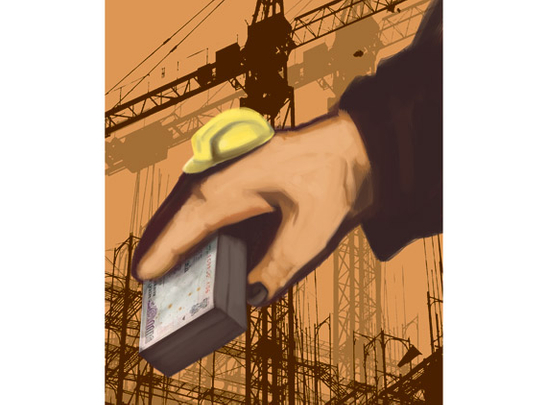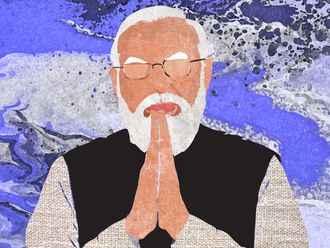
A "shameful mess and absolutely typical of that contractors' city," said a friend in Kolkata when I asked him about the Commonwealth Games in Delhi.
He meant that both contractors and politicians had made money, the second through bribes from the first, the first through the wide margin of profit offered by over-invoicing and cheap workers and workmanship.
The acronyms of the Indian government's anti-corruption agencies crop up frequently.
The Central Vigilance Commission (CVC) is keeping "a hawk's eye" on the 14 projects it has put "under the scanner". The Central Bureau of Investigation (CBI) is looking into alleged financial irregularities that run into "thousands of crores" (a crore is Rs10 million).
I was struck by my friend's phrase: that contractors' city. In a 100 years, Delhi's population has grown from 400,000 to about 18 million and is expected to grow by another 40 per cent by 2020, when it will be the world's third-largest urban agglomeration after Tokyo and Mumbai.
None of this frightening enlargement would have been, or will be, possible without contractors to build the homes and the infrastructure. London likes to think of its Olympic park as a significant challenge in terms of planning and construction, but London is a city in stasis compared to Delhi.
To a Londoner, the word ‘contractor' suggests nothing very much — Irish labourers, once upon a time — but a Delhiite has a more concrete picture of individual energy, wealth and political connection. The city's history partly accounts for it.
Which contractors built Victorian London is a question even a well-informed architectural historian might struggle to answer, but ask the same of Delhi's 20th-century history and many of its citizens will know.
When I first saw Delhi in the 1970s, it was still recognisable as the city that the English architects Edwin Lutyens and Herbert Baker had planned as the new capital of British India.
History
Delhi, of course, already existed; it was an old capital of the Mughal empire, and as an important place of human settlement it stretched back for centuries before the Mughals arrived. Among the scattered ruins of these earlier rulers — tombs, forts, mosques — New Delhi arose as the replacement for Kolkata, to give the British administration a distance from the rising nationalist hubbub in Bengal.
King George V announced the move at his Delhi Durbar of 1911 and the nearly finished city was inaugurated in 1931 "five minutes before closing time", as Nikolaus Pevsner once remarked.
In 1977, 30 years after the Raj had closed, New Delhi was still characterised by its broad tree-lined avenues and neoclassical bungalows. It had a cultured class, generous to strangers, which included several notable people called Singh who edited magazines, wrote newspaper columns, ran restaurants and galleries and were socially committed.
Good life
Few of these activities were very profitable, and yet these Singhs lived well, in the kind of home usually then given over to foreign diplomats and non-governmental organisations.
Any mystery in the contradiction was shortlived. Everybody knew that their fathers and grandfathers had made fortunes as the contractors who built New Delhi to the designs of Lutyens and Baker.
Several were Sikhs from western Punjab and the most celebrated of them, Sobha Singh, was rewarded with a knighthood for his professionalism. Contractors on the New Delhi project had employed thousands of men (perhaps children, too) to build a city from scratch.
Hills had been demolished, railways laid, palaces built, stone in millions of cubic feet cut, transported and erected. Did the contractors offer bribes to win their commissions?
There's no evidence to suggest so. The code of the Indian civil service allowed no gift greater than fruit or flowers and in the 1920s the morality within imperialism was probably at its highest (though, then again, the secrets of the hierarchy in those days were generally better kept).
In other ways, however, the story of the Commonwealth Games can find echoes in the past. Lutyens, fretting that his grand viceregal palace would never be finished, complained about the workmanship.
"The Indian never finishes anything," he wrote, "and breaks 50 per cent of what he temporarily fixes so that the amount of making good shall be at least 25 per cent of the work done and at the cost of another 25 per cent there is not near enough skilled supervision and no one seems to care so long as they can get to their clubs, gymnasiums and whist and bridge drives."
Lutyens certainly wasn't the most sympathetic visitor India has ever seen. "They want me to do Hindu [architecture]. Hindon't I say" but perhaps he was right to fret. In March 1927 a brick fell from the ceiling of the newly completed legislative chamber and nearly brained Field Marshal Sir William Birdwood.
The building's architect, Baker, insisted the fallen object had been merely an acoustic tile that had been insecurely fixed in damp plaster during "the extreme dry heat of an Indian summer".
The same alarm, and the same response, met the news last month that few pieces of plastic ceiling had dropped to the floor of the wrestling venue.
In the end, the vistas and public buildings of Lutyens' and Baker's New Delhi came to be seen as a triumph. Their work gives the modern city its distinction, which the international modernism of sports stadia and athletes' villages will never do.
Still, the time for churlishness is over. We must forget the collapsed bridge, and ceiling tiles on the floor and hope for the best.











